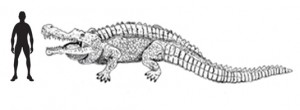New Crocodile Exhibition to Celebrate Darwin’s Birth
Crocodile Exhibition to Celebrate Darwin 200
An Australian museum is putting on an exhibition showcasing the evolution of the crocodile as part of their celebrations marking the 200th anniversary of Charles Darwin’s birth. The exhibit which is on display at the Northern Territories Museum and Art Gallery in Darwin is open until November.
Darwin itself, was named after the famous English scientist, he visited the area when the ship, HMS Beagle docked in September 1839, part way through its surveying expedition. Australia has two native species of crocodile, the Saltwater or Estuarine and the smaller freshwater crocodile. The Saltwater crocodile (Crocodylus porosus) is the largest living reptile with some specimens reaching lengths in of over 6 metres.
The exhibition is entitled “Supercrocodilians: Darwin’s ultimate survival story” is free to enter and tells the story of the evolution and development of this remarkable reptile group, one that has outlasted the dinosaurs.
Commenting on the events programme, exhibition curator Paul Horner said:
“We wanted to show Charles Darwin’s theory of evolution through an icon like the crocodile”.
Animals that were similar to modern crocodiles (phytosaurs) evolved around 240 million years ago. Crocodiles as a group have been around since the Late Triassic period with the ancestors of the modern species known today (23 species of crocodiles in the world at present, although most are endangered), being traced back to the Cretaceous (neosuchians). Some of the species of crocodilian around today may have remained largely unchanged for 5 million years or so. The crocodilian life style of being a heavily armoured, ambush predator of rivers and lakes does seem to be a formula for a sustained run in terms of survival. However, in their evolutionary history crocodiles have evolved to exploit a variety of environmental niches, from almost entirely marine forms such as Metriorhynchus, to fast running entirely terrestrial types.
The exhibition highlight is the reconstructed skull of a 15 metre long giant crocodile called Sarcosuchus. This particular crocodile, now fortunately extinct, lived in Africa during the Cretaceous period and although it had a long snout adapted for catching fish, it probably ambushed dinosaurs as they came down to drink.
Pictures show the skull of a Sarcosuchus and museum curator Paul Horner is dwarfed by it. Even allowing for the change in perspective as Paul is further from the lens than the crocodilian skull, the cast of this fossil skull is very impressive. Note the hooked tip to the upper jaw and the many sharp, needle-like teeth, believed to be adaptations to help catch slippery fish. Such a jaw configuration and dentition is seen in baryonychid dinosaurs, which were also believed to be fish-eaters in the main.
A Scale Drawing of a Prehistoric Crocodile – Sarcosuchus
Picture credit: Everything Dinosaur
The exhibition has been planned for over a year and is a fitting tribute to Darwin, after whom the city is named and also highlights a need to conserve these remarkable and dangerous creatures.
Team members at Everything Dinosaur have been working on a model of Sarcosuchus that is being introduced later this year. Drawings have just been commissioned so that a fact sheet can be created for this new item. Scientists remain unsure as to which type of crocodilian was the biggest of them all. Sarcosuchus is a contender, along with the more heavily built Deinosuchus and the later Purussaurus from South America that lived during the Late Pliocene. This particular crocodile, believed to be more closely related to modern Alligators could reach lengths in excess of 16 metres.
To view models of a variety of prehistoric crocodilians and other related species: Dinosaur, Crocodilian and Prehistoric Animal Models.


